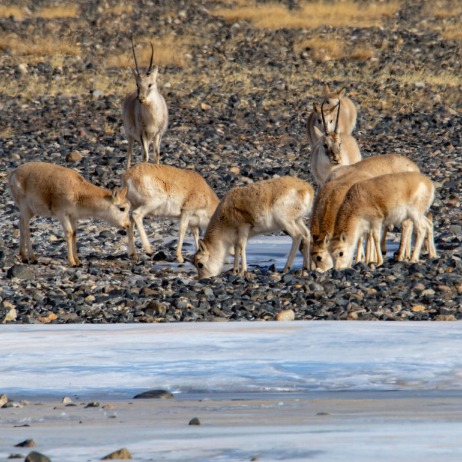



No pregnant woman would hike 400 kilometers on foot through remote areas of western China just to have her baby. That's why humans have hospitals.
But that's what female Tibetan antelopes do. And after they have had their babies, they turn around and go 400 kilometers back to where they started, an 800 km total round trip-admittedly on four legs rather than two, but it's still a daunting distance.
Tens of thousands of pregnant Tibetan antelopes are now making their way across the high grasslands of the Tibet autonomous region, with some of them no doubt greeting old friends who started the journey earlier and are on their way back with their surviving babies. Most newborns die in the harsh conditions.
Every year starting from early May, the animals begin their long walk, impelled by Mother Nature, after mating in November or December. They make the return trip around August.
The annual migration happens in areas including Tibet's northern Changthang grassland, the Hoh Xil National Nature Reserve, the Three-Rivers-Source National Park in the Yushu Tibetan autonomous prefecture of Qinghai province and Altun Mountain in the Xinjiang Uygur autonomous region.

Wu Xiaomin, an expert from Shaanxi Institute of Zoology, said the population of the once-endangered species has increased dramatically in the last few decades thanks to enhanced protection efforts -including more aggressive enforcement of anti-poaching laws and measures to improve the animals' habitat.
The antelope are a first-class protected species in China, but they are making good progress in numbers. The population of the species has grown from 60,000 or 70,000 in the early 1990s to around 300,000 now.
"Every year starting from around May, all the female antelopes, including 2-year-olds, take part in the migration," said Wu, who also works for the Northwest Institute of Endangered Zoological Species.
Wu said the habitat for the Tibetan antelope in China covers more than a million square kilometers, mostly in remote, severe environments with altitudes between 3,700 meters and 5,500 meters.
"Because of climate change, the migration time of the antelopes during which they give birth is coming a few days earlier, and their longest migratory route could reach to 800 km if measured in a straight line," Wu said.
More than 90 percent of the female animals give birth every year, but only about 30 percent of the newborns survive. Many of the babies die on the journey, unable to hold up under the extreme conditions, which include predators and disease.
Wu said there are more than 200,000 of the antelopes in Tibet's northern Changthang grassland, more than 70,000 in the Hoh Xil areas and more than 20,000 in Xinjiang.
From a survey trip he took to observe the migration in July 2020, he happened to observe a herd of more than 60,000 migrating antelopes at close range in Rongma township of Tibet's Nyima county.
"I was shocked to see such a big herd," he said. "I felt what turned out to be a magnitude 6.6 earthquake early in the morning, but I had a pleasant time for the rest of that day."

Thanks to the government's protection efforts, patrol stations are abundant. However, there is a slight problem of conflict between nomads and wildlife in Tibet, he said.
"The nomads put fences on the grassland to protect the grass and distinguish their own share of grassland, but sometimes these hinder the normal activity of the Tibetan antelopes," he said, adding that passageways must be cut through the fences to let the animals through.
"The government of the Tibet autonomous region has taken action in recent years to give more protected space to wildlife by relocating nomads from places at altitudes above 4,800 meters to other places in the region," he said.
"Relocation of nomadic families from extremely high altitudes is a smart measure, and we also need to have more high-tech facilities to carry out surveys and protection work in the reserves."
According to a staff member at the Nagchu bureau of forestry and grassland, the city has been working to provide a better habitat for many rare wildlife species, including the Tibetan antelope. The city's ecological protection measures include operating 73 management stations. In addition, it employs 780 professional patrol officers who have worked year-round for the safety of wildlife since 2015.
Around the habitat of the Tibetan antelope in the Serling Tso National Park in Shanza and Palgon counties, 64 full-time staff guard the passageways, resting areas and birthing places.
If you have any problems with this article, please contact us at app@chinadaily.com.cn and we'll immediately get back to you.